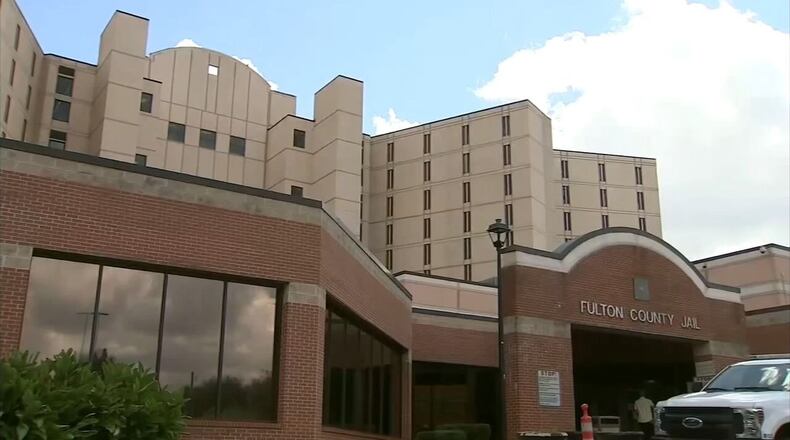A new Fulton County jail could easily cost $2 billion, but a bigger and better facility is badly needed — and soon, the county board of commissioners heard during a meeting on Wednesday.
In a three-hour presentation, consultants from architectural firms STV and TreanorHL summarized their 300-page report on a new jail that, they say, would serve area needs for at least 25 years.
Sheriff Patrick Labat presented the proposal to commissioners as an opportunity to create a “criminal justice complex” with access to mental health and education services, not just a jail.
“It’s time to stop warehousing people and treat them like they’re human,” the sheriff said.
The main jail on Rice Street is “falling apart,” with prisoners frequently crafting knives from parts of the building, leading to regular stabbings, Labat said. That creates liability for the county, and could lead to renewed federal intervention, he warned. Fulton County’s jails were under federal oversight for 11 years, ending in 2015.
Fulton County’s jail system is chronically overcrowded, with a pandemic-related case backlog exacerbating the problem. As a stopgap, the county sends about 250 inmates to Cobb County, and recently agreed to lease 700 jail beds from the city of Atlanta, potentially costing $50 million over a four-year span.
Consultants acknowledged that many variables went into their size and cost estimates, and that those could change at any time as laws and conditions change.
Consultants presented high, middle and low estimates of need, based on possible changes to incarceration rates, court backlogs and related factors. The maximum was for a jail with about 6,400 beds, but they recommended a “moderate” forecast of about 5,700 beds.
That assumes about 4,800 inmates on an average day, but jails need an extra 20% capacity to allow separating inmates, moving them around, and occasional surges, consultants said.
The projected $2 billion cost is for the middle scenario, assuming construction from April 2026 to December 2028. That could vary by up to 20% depending largely on inflation, consultants said.
All proposed financing options would cost the county at least $122.5 million a year for more than three decades, not including the still-unknown expense of greatly expanded programs.
Commissioners questioned how consultants arrived at their bed and space recommendations, and how much operations would add to the cost.
“If we build it, can we maintain it?” Commissioner Bridget Thorne asked. Commissioner Natalie Hall noted the need to calculate costs of expanded services.
But Commissioners Khadijah Abdur-Rahman and Dana Barrett said the cost of inaction, or building an inadequate facility, would be even higher and cause future problems.
Officials know the current system and facility don’t work, and that addressing mental health is vital, Abdur-Rahman said. While commissioners have to be mindful of taxpayers’ money, they also must ensure any new facility is adequate for many functions, she said.
A year ago the consultants received a $1.2 million contract to study the need for a new jail, culminating in Wednesday’s presentation. They offered comparisons with jails being built in other large urban areas, but Labat broke in with surprise when consultants said they didn’t consider jails in Gwinnett and other adjacent counties.
“I’m about to ask for a refund,” he said. Labat said he specifically asked for those comparisons and other questions that remained unaddressed.
Building a new jail is a “legacy-making” decision for commissioners, and he was angry to see many questions seemingly being taken lightly, Labat said.
The recommendation calls for a facility of nearly 2.2 million square feet, roughly four times the size of the county’s current jail. But 42% of that space would be dedicated to services and amenities for inmates and staff, while more than 1,500 beds would serve inmates with mental health issues.
The report cites expectations of Metro Atlanta population growth by more than 1 million in the next 25 years, with a corresponding growth in the jail’s average daily population; plus a trend toward more serious charges and longer average stays.
The report says the new jail should “create a normative (not punitive) environment,” focus on case management and reentry services, and provide amenities that help retain staff.
It proposes a vast expansion of healthcare and mental health housing. Now 90% of jail space is taken up by housing units; the report recommends that overall housing take up 68% of a new jail, with nearly half of that dedicated to healthcare and mental health units. The added housing could be built in phases.
Consultants recommend using the 35-acre current jail site at 901 Rice St. NW. The existing building wouldn’t be torn down until enough parts of the new one are built to house prisoners at that time. But using that site would require moving some other functions and make construction more complicated.
The county should “build for the short term, plan for the long term,” with room to expand as needed, said principal consultant John Eisenlau said.
County jails are meant for pre-trial detention, and the current 35-year-old building is neither safe nor humane, he said. It holds two and a half times the number of people it was designed for, and dismal working conditions contribute to a growing problem in hiring and keeping staff, Eisenlau said.
Keep Reading
The Latest
Featured



